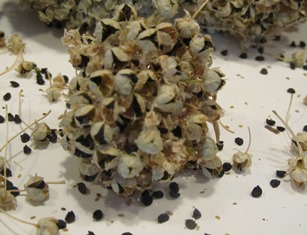Gathering Seed for Next Year’s Garden
The sounds of summer around our farmette have grown quieter. It’s mid-August and the neighborhood children have returned to school. I miss their laughter. I miss the delight on their faces at seeing the chickens and the honeybees. I miss keeping them company at their lemonade stand.
But I admit to the secret pleasure of solitude and quiet, though it isn’t really silence. It’s the peaceful clucking of chickens and the twitter of songbirds as I gather seed from plants that have bloomed and dried, such as the cosmos, nasturtiums, sunflowers, and wisteria.
The wisteria vine that exploded in growth of long, green tendrils during spring and early summer and graced us with bracts of purple perfusion now hold heavy pods. The pods contain seeds that can be dried and planted for new vines next year.
The sword-shaped leaves of the irises are dry–their blooms a memory from early spring. I’ve already cut their long leaves back into four-inch fans and will dig some of the rhizomes for replanting in other beds around the farmette.
The sunflowers that the bees love to forage on have gone to seed. Those seeds will become next year’s plants, but some we’ll save for the squirrels.
The red and yellow onions have developed seed pods on long shoots now. I’ll plant those in raised beds in the fall for a spring crop of onions.
Yes, the dog days of summer have come around again. But the growing season continues. End of summer gives rise to autumn when grapes, persimmons, pumpkins, figs, and pomegranates ripen. On the farmette, there is always another season and other crops to look forward to with anticipation. It’s the good life.
Iris Reward with Sensational Spring Blooms
Few flowers do the double duty of iris in a flower garden. They provide a great background for other flowers and also produce exquisite blooms on their tall stems. Both bearded and beardless iris plants provide textural interest for other perennials, annuals, and herbs, whether in a formal or informal flower bed, along a walkway, or tucked into a corner of a garden.
Iris produce their blooms on stalks that emerge from clumps of stiff, erect, spiked, and pointed green leaves. My iris plants were a gift from the neighbor who owns the property behind the Henny Penny Farmette. The bulbs she gave me had originally been planted by her father and mother, both now deceased. We were thrilled to get the bulbs.
When we planted them on our property, we made sure the soil was amended and we sprinkled in some bone meal and watered well. Then the iris were left alone. We did apply mulch prior to the winter rainy season and because here in the inland valley of the east bay, we can get freezing nighttime temperatures. Those iris plants have rewarded us with spectacular blooms in April each year.
We didn’t know if the bulbs would produce a true blue bloom or some other color, so the anticipation was killing us that first year. Then the buds emerged on tall (roughly three foot stalks) and we could see what was coming. I have to say, the blooms bedazzled us.
Plant height separates the bearded iris into roughly five groups: miniature dwarf, standard dwarf, intermediate, miniature tall, border, and standard tall. Our iris plants fall into the standard tall category. The best time to plant the iris rhizomes is from July to September 15. Set the rhizomes just beneath the soil surface as they do not like being planted too deep. In really cold areas, a thick layer of mulch ensures the rhizome survives alternate freezes and thaws. Lift and divide the rhizomes right after blooming. You can cut the leaves back to six inches for ease in handling the plants.
A note about rhizomes: These thick horizontal stems generate roots from the bottom and the plant’s leaves and flowers emerge from the top. Some plants that grow from rhizomes are bearded irises, calla lilies, and cannas.
 Facebook
Facebook Goodreads
Goodreads LinkedIn
LinkedIn Meera Lester
Meera Lester Twitter
Twitter











